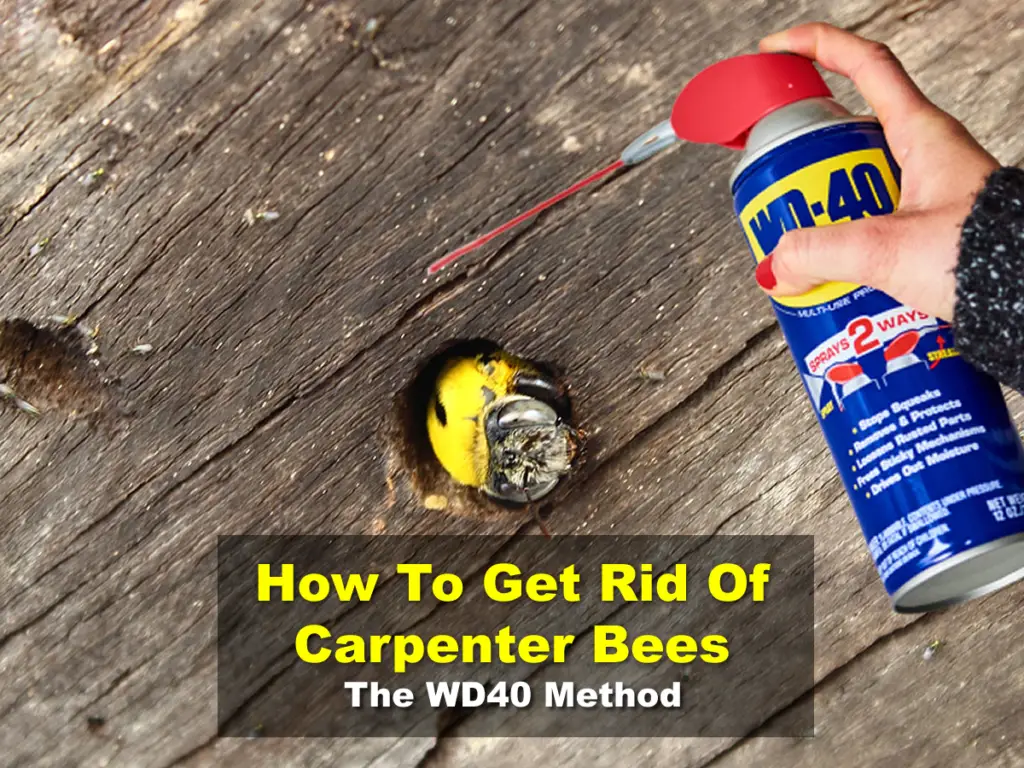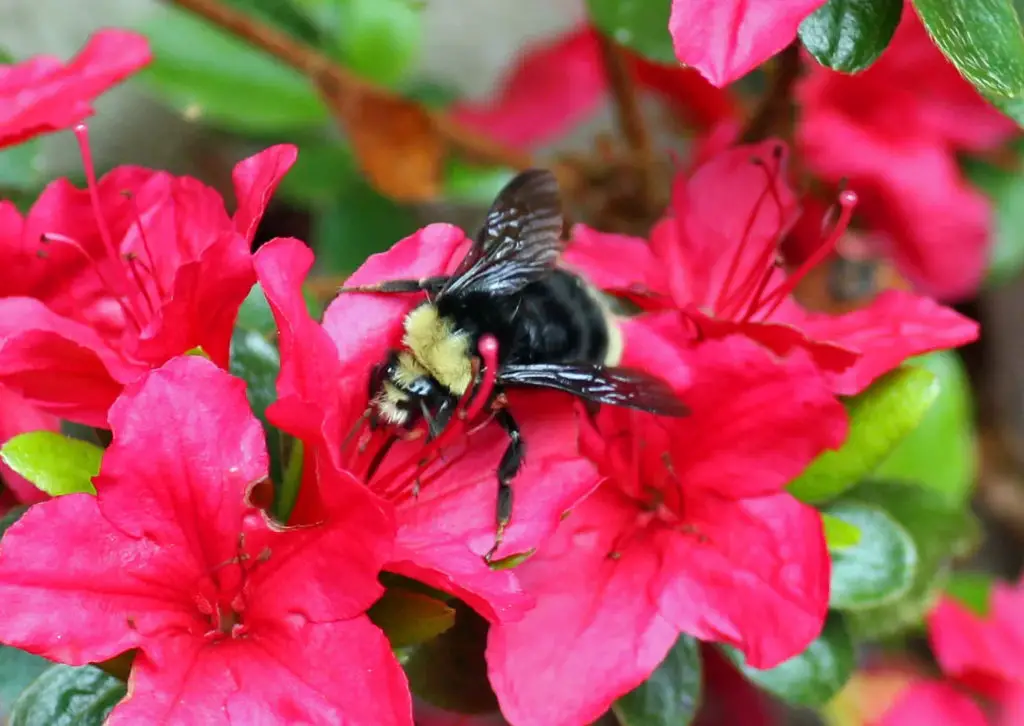Affiliate Disclaimer - As an Amazon Associate I earn from qualifying purchases.
It supports the website. So, Thank you
Carpenter bees are harmless for the most part and are not usually aggressive towards humans unless they feel threatened. However, since these insects bore into wood to make their nests, they can often be a nuisance around the home and garden and end up nesting where they’re not welcome.
There are lots of ways that you can treat a carpenter bee problem and people keep asking about using WD40. But does this method actually work?
WD40 contains mineral spirits which are toxic to carpenter bees and a whole host of other insects. Using this product to eliminate carpenter bees will be effective but is it the most ethical?
If there’s one thing I’m passionate about when it comes to bees, it’s being kind to them. They are so important to the ecosystem as pollinators so where possible, I would urge you to find ways of removing them without harming them.
Of course, in the most severe situations, you may not have a choice but to go in all guns blazing. In that case, you’ll need to know how to get rid of carpenter bees with WD40.
Table of Contents
What Is WD40?
WD40 is a water displacing spray and the term WD40 is simply a brand name. There are other water displacement products on the market and they all work in the same way so feel free to choose whichever you like. WD40 is the most popular option.
WD40 is a petroleum-based product that also contains ingredients such as carbon dioxide, mineral oil and hydrocarbons. It is used as a lubricant on rusted metal as well as for things like removing adhesive and cleaning. Many people also use WD40 as a preventative product to protect metal from corrosion and rust or even frost.
Does WD40 Work To Get Rid Of Carpenter Bees?
Since WD40 is oil-based, containing things like mineral oil and hydrocarbons, it has the ability to kill carpenter bees and other insects. These ingredients are incredibly toxic and will affect the bee’s respiratory system by closing up the air holes, preventing oxygen from flowing. The end result is that the bee dies of asphyxiation.
What’s great about using WD40 is that it not only affects adult bees but can also be used to get rid of eggs. Carpenter bees lay their eggs inside the wood by making holes so they can be difficult to access. But WD40 easily penetrates the wood and will coat the eggs in a layer of oil. This means that oxygen cannot get to the egg, eventually killing it.
And if that wasn’t enough, you can also use WD40 to prevent carpenter bee infestations as well as stop other insects from setting up shop in and around your home. Carpenter bees have a very sensitive sense of smell and with WD40 having such a potent odor, this is very offensive to them. When used as a repellent, WD40 is effective since it will repel the bees without the need to harm them.
That said, you should be careful as it is a very volatile substance so may not be suitable for long-term use.
How To Use WD40 To Kill Carpenter Bees
I must stress that using WD40 will kill any bees that are nesting in your wooden structures. This should be used as a last resort when natural methods have failed because killing bees can have a damaging effect on the local ecosystem. However, if you find yourself in a situation where you have no other choice, allow me to instruct you on how to use the WD40 method for carpenter bees.
- Start by locating the areas that are a problem. When looking for carpenter bee holes, you’ll need to search for ½ inch holes that are almost circular in shape. They’re usually in specific types of wood such as pine, cedar, oak, or redwood although they may be found in other wood species.
- Areas around the home that may become infested could be railings, decks, doorposts and anything else made from wood regardless of whether the wood is treated or not. Pay attention to where the bees are hovering and you’ll likely find their nest close by.
- You’ll now need to take your can of WD40 and attach the straw extension to the nozzle; this will allow you to direct the spray more precisely in tight or small areas.
- I’d recommend performing the treatment during the evening as this is when the adult bees will return to the nest. If they’re not in, you won’t kill them.
- Insert the extension into the carpenter bee hole as far as possible and begin spraying the product. You’ll want to continue spraying for up to 20 seconds to ensure that the entire inside of the hole is covered. If the WD40 is foamy then you’ll notice this spilling out of the hole so it’s important to clean this up when you’re done.
- Once you have finished spraying the WD40, you’ll need to make sure that any holes are plugged up. This will further reduce airflow and will kill the bees more quickly. You can use something like wood putty or caulk clay for this.
Is WD40 Safe?
If you read the label on a bottle of WD40, you will see that it contains lots of ingredients that can be harmful, especially when ingested. But even breathing the product in can cause unpleasant symptoms such as headaches, nausea, dizziness, and even respiratory infections.
For this reason, I would always advise using protective gear such as a respirator or mask when you are spraying the product. Make sure that any pets or children are kept well out of the way and, where possible, opt for natural treatments to get rid of carpenter bees.
It’s also worth considering the effect of WD40 on the environment due to the petroleum within it, which is not biodegradable. Since it also contains carbon dioxide, WD40 is considered harmful to the ozone layer.
While WD40 will effectively and quickly kill carpenter bees, you have to consider whether this is the best option. There will be times when natural methods won’t work but I would advise contacting a professional pest controller before using WD40.
Other Methods To Get Rid Of Carpenter Bees Naturally
As I have mentioned throughout this guide, WD40 should never be your go-to method for killing carpenter bees. Not only is it harmful to the environment and potentially your family but WD40 will eradicate bees which could have a wider effect on the ecosystem.
If you’re keen to get rid of your unwanted guests in a gentler way then there are options and I’ll discuss these briefly here. Although I do have a more in-depth guide on getting rid of carpenter bees if this is something you’re interested in reading.
- Using a citrus spray is a brilliant way to tackle problems with carpenter bees. They cannot stand the scent and will quickly leave an area that is doused in it. It’s easy to make your own citrus spray at home by boiling the fruit peel in water for a few hours and then transferring the liquid to a spray bottle. You’ll need to treat the wood every few days if you want the bees to leave and stay away.
- Almond oil is another great natural method for repelling carpenter bees and works in a similar way to citrus spray. The bees really don’t like the smell and won’t make a nest as long as the oil is present. While this is usually a preventative method, you may find that you can get the bees to leave by using almond oil although it’s not the most effective natural method.
- One of the simplest methods for getting rid of carpenter bees is to use a vacuum. If your vacuum has a small attachment that can fit into the nest opening and the bees are not very deep, you could suction them out. However, keep in mind that you won’t have much luck vacuuming any eggs so you will need to seal the nest afterwards.
- It might sound crazy but making a lot of noise can sometimes be enough to drive carpenter bees away. Most people opt for loud music although I’d advise warning your neighbors before getting started. The carpenter bees hate the vibrations that come from loud music and will likely fly away. While they’re gone, you can go in and seal up those holes.

Repair Damage To Prevent Carpenter Bees
I’d also like to quickly touch upon wood repair after you have dealt with carpenter bees. This applies whether you’ve used the WD40 method or a more natural approach and if you don’t want them coming back, it’s a must!
You’ll need to assess any wooden parts of your home and check for holes; these can be holes made by bees or from other damage. When the female carpenter bee is looking for a place to nest, she’ll be attracted to damage, cracks or holes in wood as this makes her job easier. Be sure to fill these using cork or wood putty.
It’s usually best to check for, and repair damage during the fall so that everything is protected when spring comes around. By this time, most of the adults will have died anyway and the larvae will be in hibernation. If you wait until spring, you’ll have the adults to contend with which will only make the workload harder on yourself.
Final Thoughts
Carpenter bees can be a real nuisance if you have a lot of wooden structures around the home and garden. While these insects are not dangerous to humans, there aren’t many of us that want to share our space with them.
A lot of people want to know how to get rid of carpenter bees with WD40. By spraying this into the nest holes, you will kill the bees and it’s a very effective method.
However, I should warn you that there are risks associated with the use of this product as an insecticide. So take the time to figure out whether a more natural approach would be more suitable.






